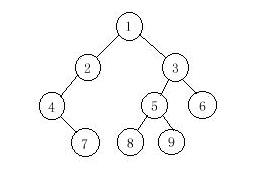hdu 1710 Binary Tree Traversals 前序遍歷和中序推後序
阿新 • • 發佈:2017-07-16
rtai clu contains root ron als div 歷遍 case
Total Submission(s): 4205 Accepted Submission(s): 1904
Problem Description A binary tree is a finite set of vertices that is either empty or consists of a root r and two disjoint binary trees called the left and right subtrees. There are three most important ways in which the vertices of a binary tree can be systematically traversed or ordered. They are preorder, inorder and postorder. Let T be a binary tree with root r and subtrees T1,T2.
In a preorder traversal of the vertices of T, we visit the root r followed by visiting the vertices of T1 in preorder, then the vertices of T2 in preorder.
In an inorder traversal of the vertices of T, we visit the vertices of T1 in inorder, then the root r, followed by the vertices of T2 in inorder.
In a postorder traversal of the vertices of T, we visit the vertices of T1 in postorder, then the vertices of T2 in postorder and finally we visit r.
Now you are given the preorder sequence and inorder sequence of a certain binary tree. Try to find out its postorder sequence.

Input The input contains several test cases. The first line of each test case contains a single integer n (1<=n<=1000), the number of vertices of the binary tree. Followed by two lines, respectively indicating the preorder sequence and inorder sequence. You can assume they are always correspond to a exclusive binary tree.
Output For each test case print a single line specifying the corresponding postorder sequence.
Sample Input
Sample Output
題意:給出前序歷遍和中序遍歷的順序,來推導後序遍歷的順序。 做法:把握兩個要點。前序是 先根歷遍的。所曾經序的第一個是根。
題鏈;http://acm.hdu.edu.cn/showproblem.php?pid=1710
Binary Tree Traversals
Time Limit: 1000/1000 MS (Java/Others) Memory Limit: 32768/32768 K (Java/Others)Total Submission(s): 4205 Accepted Submission(s): 1904
Problem Description A binary tree is a finite set of vertices that is either empty or consists of a root r and two disjoint binary trees called the left and right subtrees. There are three most important ways in which the vertices of a binary tree can be systematically traversed or ordered. They are preorder, inorder and postorder. Let T be a binary tree with root r and subtrees T1,T2.
In a preorder traversal of the vertices of T, we visit the root r followed by visiting the vertices of T1 in preorder, then the vertices of T2 in preorder.
In an inorder traversal of the vertices of T, we visit the vertices of T1 in inorder, then the root r, followed by the vertices of T2 in inorder.
In a postorder traversal of the vertices of T, we visit the vertices of T1 in postorder, then the vertices of T2 in postorder and finally we visit r.
Now you are given the preorder sequence and inorder sequence of a certain binary tree. Try to find out its postorder sequence.

Input The input contains several test cases. The first line of each test case contains a single integer n (1<=n<=1000), the number of vertices of the binary tree. Followed by two lines, respectively indicating the preorder sequence and inorder sequence. You can assume they are always correspond to a exclusive binary tree.
Output For each test case print a single line specifying the corresponding postorder sequence.
Sample Input
9 1 2 4 7 3 5 8 9 6 4 7 2 1 8 5 9 3 6
Sample Output
7 4 2 8 9 5 6 3 1
題意:給出前序歷遍和中序遍歷的順序,來推導後序遍歷的順序。 做法:把握兩個要點。前序是 先根歷遍的。所曾經序的第一個是根。
然後這個根把中序分為兩半,左邊是左子樹,右邊是右子樹。
然後遞歸下就ok了。
#include <cstdio>
#include <algorithm>
using namespace std;
struct tree
{
struct tree* l;
struct tree* r;
int val;
tree()
{
l=NULL;
r=NULL;
}
};
int pre[1010],in[1010];
int n;
tree* root;
void build(int num,int l,int r,tree *rt)//pre num in_l in_r
{
int flag=-1;
while(flag==-1)
{
for(int i=l;i<=r;i++)
{
if(pre[num]==in[i])
flag=i;
}
if(flag==-1)
num++;
}
if(flag-l>0)
{
rt->l=(tree*)malloc(sizeof(tree));
*(rt->l)=tree();
build(num+1,l,flag-1,rt->l);
}
if(r-flag>0)
{
rt->r=(tree*)malloc(sizeof(tree));
*(rt->r)=tree();
build(num+1,flag+1,r,rt->r);
}
rt->val=pre[num];
}
void post(tree* nw)
{
if(nw->l!=NULL)
post(nw->l);
if(nw->r!=NULL)
post(nw->r);
if(nw==root)
printf("%d",nw->val);
else
printf("%d ",nw->val);
}
void del(tree* nw)
{
if(nw->l!=NULL)
del(nw->l);
if(nw->r!=NULL)
del(nw->r);
free(nw);
}
int main()
{
while(scanf("%d",&n)!=EOF)
{
for(int i=0;i<n;i++)
scanf("%d",&pre[i]);
for(int i=0;i<n;i++)
scanf("%d",&in[i]);
root=(tree*)malloc(sizeof(tree));
*root=tree();
build(0,0,n-1,root);
post(root);
puts("");
del(root);
}
return 0;
}
hdu 1710 Binary Tree Traversals 前序遍歷和中序推後序
